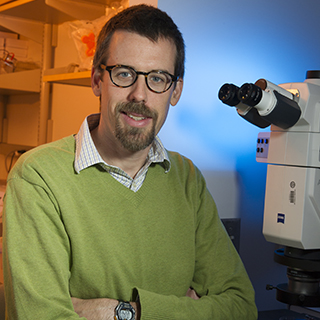A Zebrafish Model of AMD: A Novel Approach to Identify Factors that Facilitate RPE Regeneration and Functional Restoration
Principal Investigator
Project Goals
Geographic atrophy, a form of age-related macular degeneration (AMD) results from the progressive death of the retinal pigment epithelium (RPE), triggering photoreceptor degeneration in the retina and ultimately in blindness. In advanced disease, we have no effective therapies to restore lost RPE cells or slow their degeneration. In contrast to mammals, zebrafish possess a remarkable ability to regenerate lost tissues after injury, and they are a heavily utilized model system for studying the process of retinal regeneration. Our research demonstrates, for the first time, that they can also repair damage to the RPE and the experiments we have planned for this project will shed light on this process by identifying critical factors required to initiate and sustain the regenerative response. Once we understand how the zebrafish achieves this regeneration during its normal lifespan, our future goals will be to determine why mammals, like us, are unable to regenerate RPE cells and whether any of the pathways the zebrafish utilizes can be activated in mammals to stimulate RPE regeneration and restore cells lost in AMD patients.
Project Summary
The goal of our work is to determine whether the human RPE can be stimulated to regenerate.
Geographic AMD (also called geographic atrophy) results from progressive atrophy of the RPE, resulting in photoreceptor degeneration and ultimately, in blindness. While much has been learned about mechanisms leading to RPE loss in AMD, and despite recent advances in the identification of promising ways to generate RPE stem cells and stem cell-based therapies, our understanding of RPE regeneration and the integration of new RPE cells with damaged retinal tissue remains cursory. Understanding these processes is fundamental to developing effective therapies. Zebrafish possess a remarkable ability to regenerate eye tissue after injury. Indeed, our preliminary studies have demonstrated that following an RPE-specific injury, zebrafish regenerate RPE tissue. This is an exciting discovery and using this model, we will now determine the source of regenerated cells and identify the genes and pathways required for the regenerative response. These genes and pathways will represent immediate candidates around which therapeutic interventions for AMD can be developed.
Our work is innovative because it capitalizes on the ability of the zebrafish to regenerate RPE tissue. This ability is lost in mammals and humans and we don't know why. By studying the process in zebrafish, we can determine how RPE regeneration is stimulated and regulated. That will enable us to identify suspected barriers to RPE regeneration in humans, and ultimately, to develop therapies aimed at circumventing these barriers. Any such therapy that stimulates the formation of new RPE cells would provide an immediate benefit to the myriad patients afflicted with AMD and other blinding disorders that affect the RPE.
Publications
Hanovice NJ, Leach LL, Slater K, Gabriel AE, Romanovicz D, Shao E, Collery R, Burton EA, Lathrop KL, Link BA, Gross JM. Regeneration of the zebrafish retinal pigment epithelium after widespread genetic ablation. PLoS Genet. 2019 Jan 29;15(1):e1007939. doi: 10.1371/journal.pgen.1007939. [Epub ahead of print] PubMed PMID: 30695061 

First published on: July 19, 2016
Last modified on: December 19, 2024
